Family : Labridae

Text © Giuseppe Mazza

English translation by Mario Beltramini
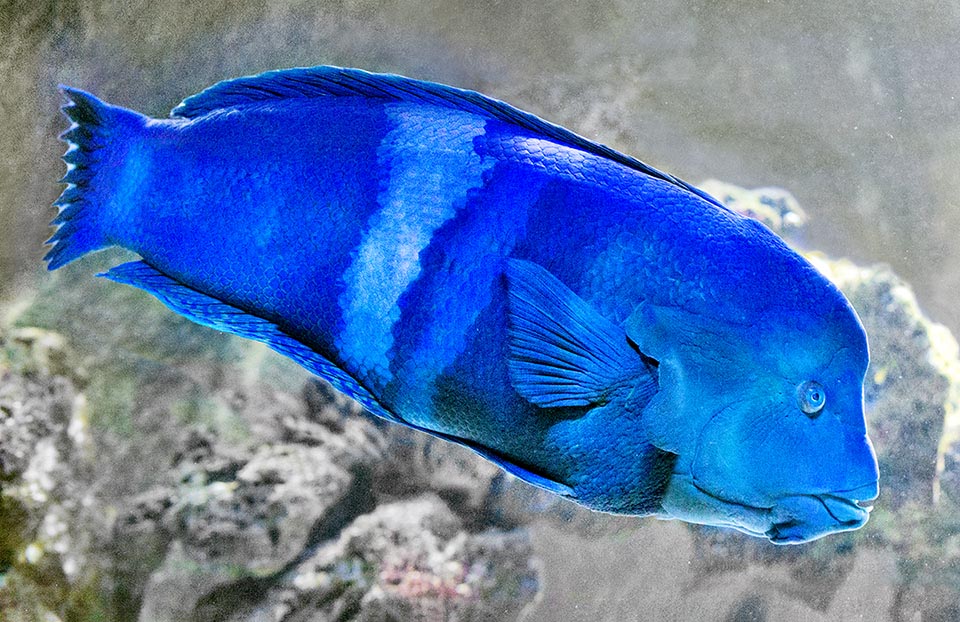
The Clown coris (Coris aygula) has a very vast distribution in the tropical waters of the Indian Ocean and of the Pacific, with males that may reach the length of 120 cm © Giuseppe Mazza
The Clown coris (Coris aygula Lacepède, 1801), belongs to the class of Actinopterygii, the ray-finned fishes, to the order of Perciformes and to the family of Labridae.
The name of the genus Coris comes from the Greek “kore”, meaning maiden, young girl, and actually, also here, as in Coris formosa or Coris gaimard, the elegance of all the liveries of Coris aygula can only evoke images of beauty.
The name of the species “aygula” = which in Sanskrit means finger, thumb and penis, refers to the first two rays of the dorsal, which erect taller then the others.
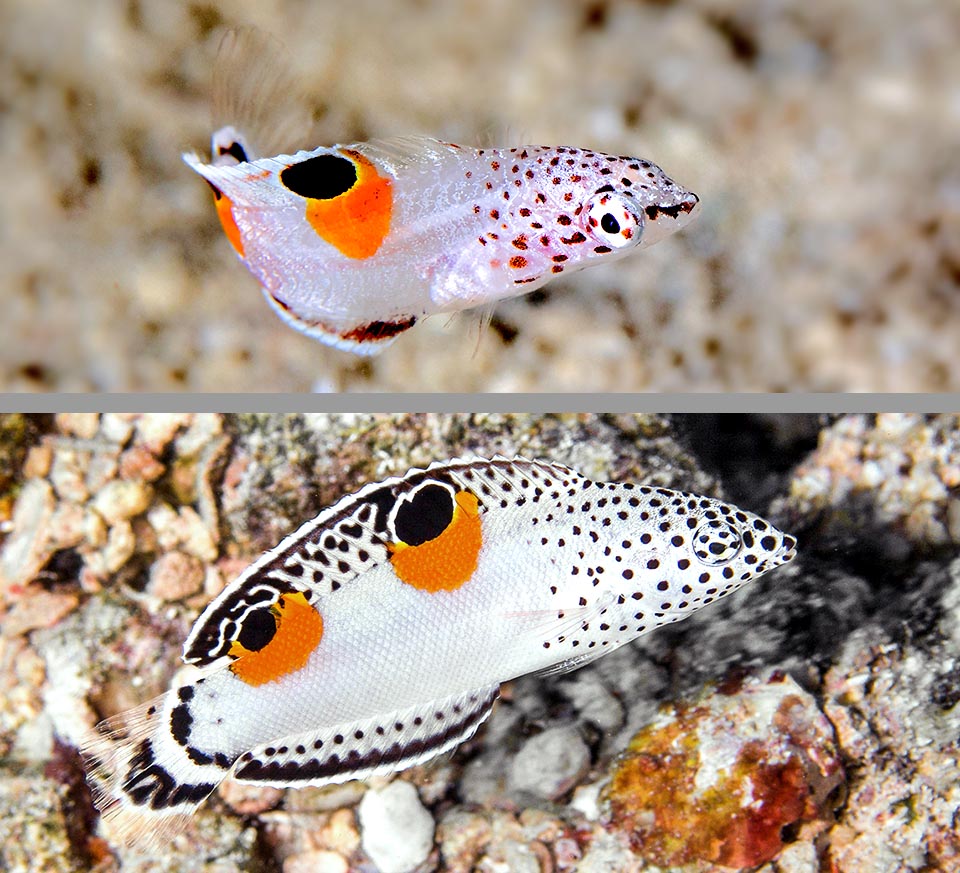
First liveries of Coris aygula. Up, a very young small fish with two fake eyes and a very fine mimetic punctuation accentuated by the growth in the specimen below © Rafi Amar (above) and © Brian Cole (below)
In the synonym Coris angulata, used till short time ago, reference was made to the angular profile of the head of the adult males.
Zoogeography
It has very vast distribution in the tropical waters of the Indian and Pacific oceans.
As an indication, we find it from South Africa to the Red Sea, the Seychelles, Mauritius Réunion, Maldives, India, Sri Lanka, Australia, Indonesia, Micronesia, New Guinea, Palau, Philippines, Taiwan, China and the Ogasawara Islands in southern Japan.
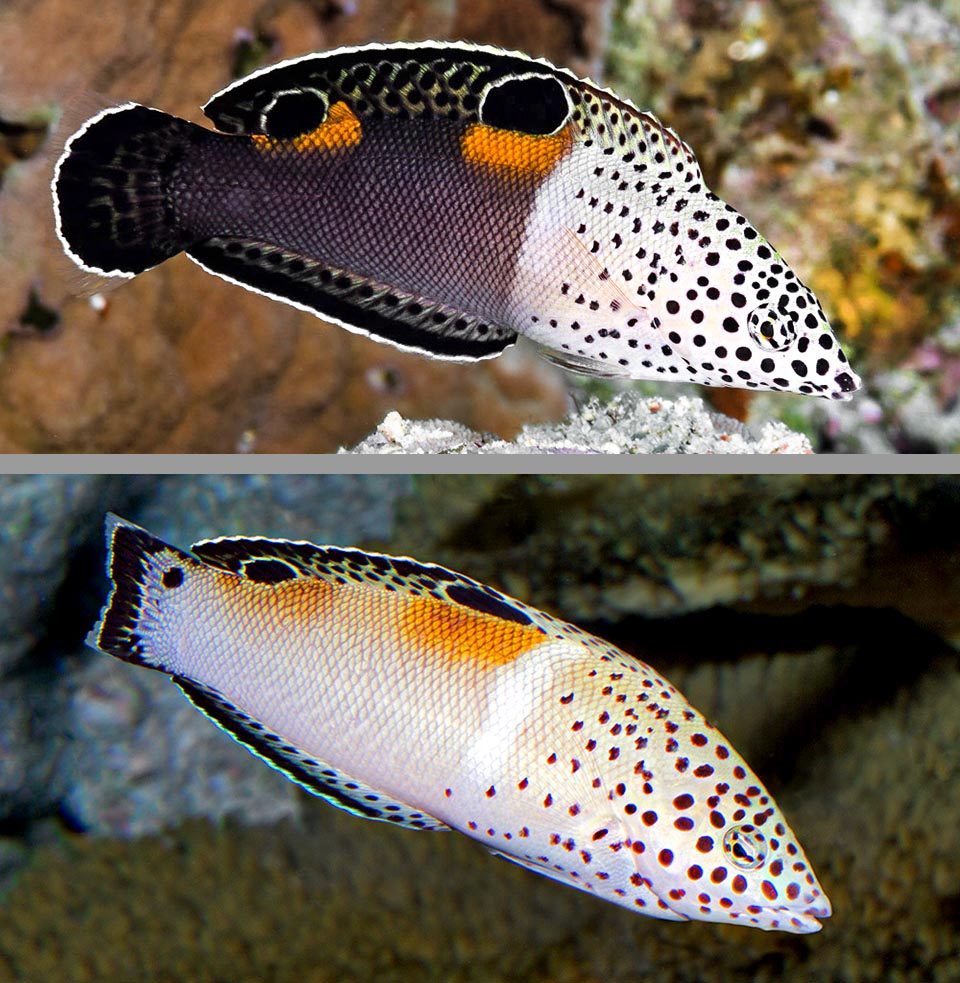
Then the ocelli regress and the fish is split in two by a vertical white band present also in the later liveries, sometimes with strong mimetic contrasts between the two zones © François Libert
Eastward, it has colonized the Fiji Islands, Samoa, Tonga, Pitcairn and Ducie. Southward, in the Pacific, it has colonized New Caledonia, Lord Howe and Rapa Island.
Ecology-Habitat
It lives in the coralline formations, in relatively shallow waters, up to about 30 m of depth.
Morpho-physiology
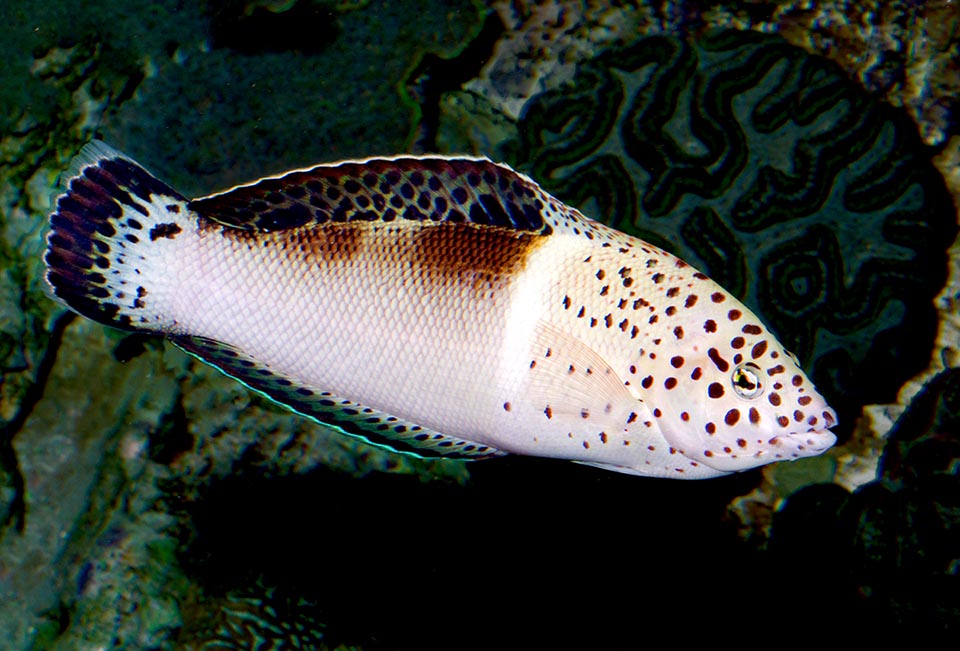
This is the typical female livery. Coris aygula is a proterogynous hermaphrodite species and the male livery manifests itself only later when it reaches a certain age © Giuseppe Mazza
The clown coris can reach the 120 cm. The shape, elongated and compressed on the sides is typical of many Coris and Thalassoma, but the size of the adults, which may reach the 120 cm of length, is really surprising.
The dorsal fin counts 9 spiny rays and 12-13 soft; the anal 3 spiny rays and 12 unarmed; the ventral ones are modest with 1 spine and 5 soft rays.
The rounded tail in the females and enriched by filamentous rays in the big males.
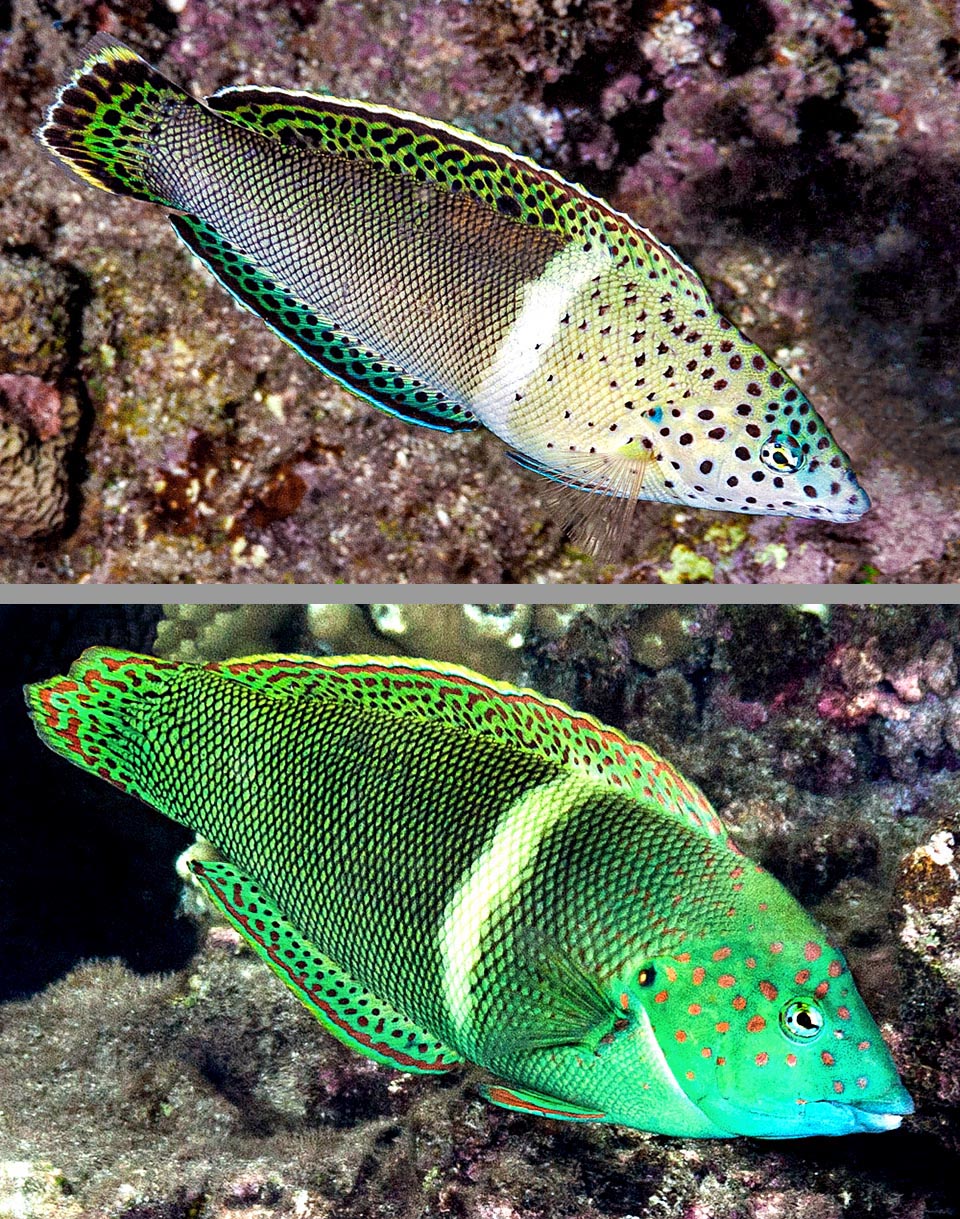
Up, the transitional livery between the two sexes and under, a young colourful male with its considerably higher body. The black punctuation has gradually turned red © François Libert
These ones, besides having the two first dorsal elongated, separated by the others by a much shorter membrane, are recognized at once by the profile showing a more evident bump over the eyes.
The livery of the adults is greenish blue with one or two paler vertical bands. The juveniles are white with small black spots in the fore part of the body and two orange spots in the back flanked, on the adjacent fin, by two great black ocelli. Later on, growing, the small black spots turn reddish and the background colour turns beige, but the centre where takes form a pale vertical band, that in hindsight is the only link with the adult livery.
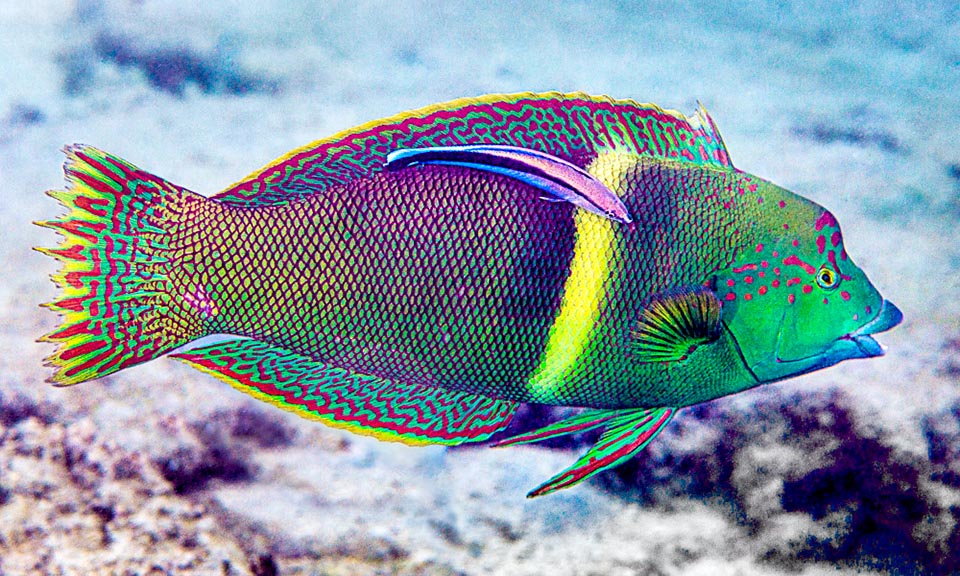
Here a splendid adult male, with the typical forehead bump, accompanied by a Labroides dimidiatus, cleaner fish that frees it from the skin parasites © François Libert
It is not astonishing, therefore, that, even accepting the well known variability of the wrasses, with all these astonishing liveries of Coris aygula numerous synonyms have generated.
Ethology-Reproductive Biology
The clown coris nourishes mainly of benthic animals: echinoderms, crusta- ceans and molluscs it seizes and easily breaks thanks to its showy protruding incisors. It often finds them by removing the bottom with strong jets of sand.
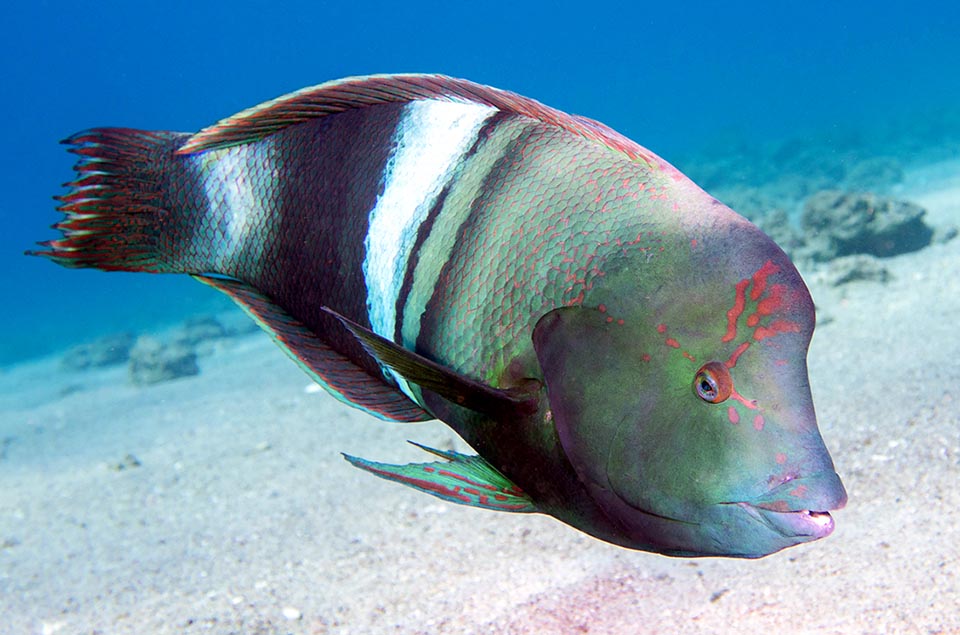
Close to the white vertical band may appear other ones less intense, up to the peduncle. The caudal fin appears frayed in the males and roundish in the females © Rafi Amar
It is thought that it is, like many wrasses, a protogynous hermaphrodite species, that is with females who may turn males starting from a certain age.
Little is known about its reproductive modalities, also because it is a rare animal with only 1-2 individuals per hectare.
The resilience, that is the capacity to fill the losses caused by the events, seems quite low for this species and after some, 14 years would be needed, under optimal conditions, for doubling the members.
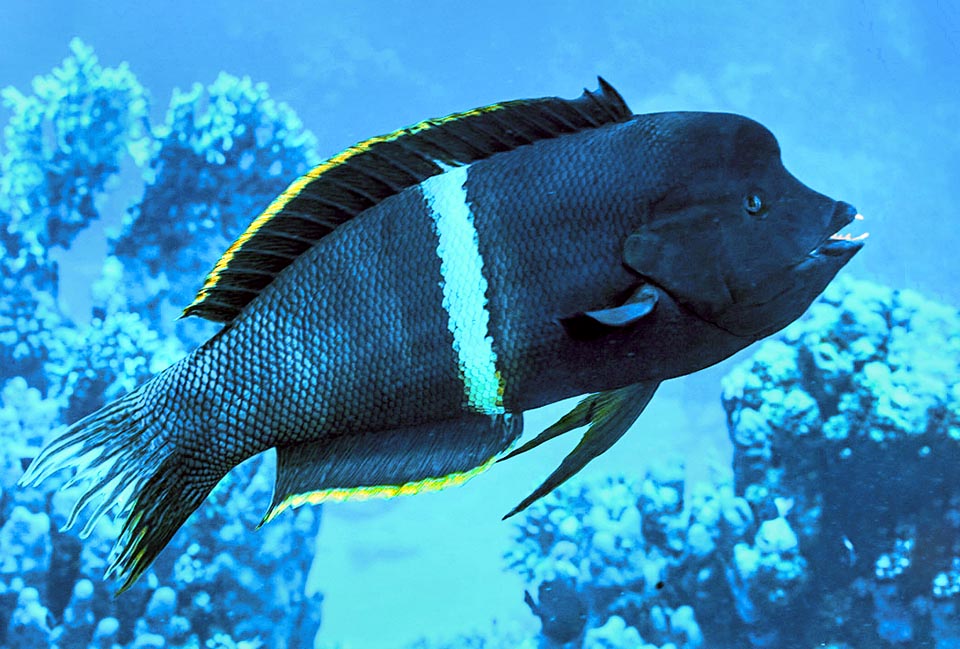
In this big male the fraying is clearly visible and we note the big protruding incisors for crushing the shells of mollusks and the defences of echinoderms and of crustaceans. Little is known about reproductive modes and the risks of this species, classified “Least Concern’ in the Red List of IUCN, because it counts only 1-2 specimens per hectare © François Libert
Though Coris aygula appears as “Least Concern” in the IUCN Red List, the vulnerability might be even high because the monitoring is scarce and no protective measures have been taken.
Synonyms
Coris angulata Lacepède, 1801; Labrus cingulum Lacepède, 1801; Hemicoris cingulum Lacepède, 1801; Julis cingulum Lacepède, 1801; Labrus aureomaculatus Bennett, 1830; Julis ruppelii Bennett, 1831; Julis gibbifrons Quoy & Gaimard, 1834; Julis semipunctatus Rüppell, 1835; Julis coris Valenciennes, 1839; Coris cyanea Macleay, 1883; Coris imbris Tanaka, 1918.
→ For general information about FISH please click here.
→ For general information about BONY FISH please click here
→ For general information about CARTILAGINOUS FISH please click here.
→ To appreciate the BIODIVERSITY of BONY FISH please click here.
→ To appreciate the BIODIVERSITY of CARTILAGINOUS FISH please click here.
